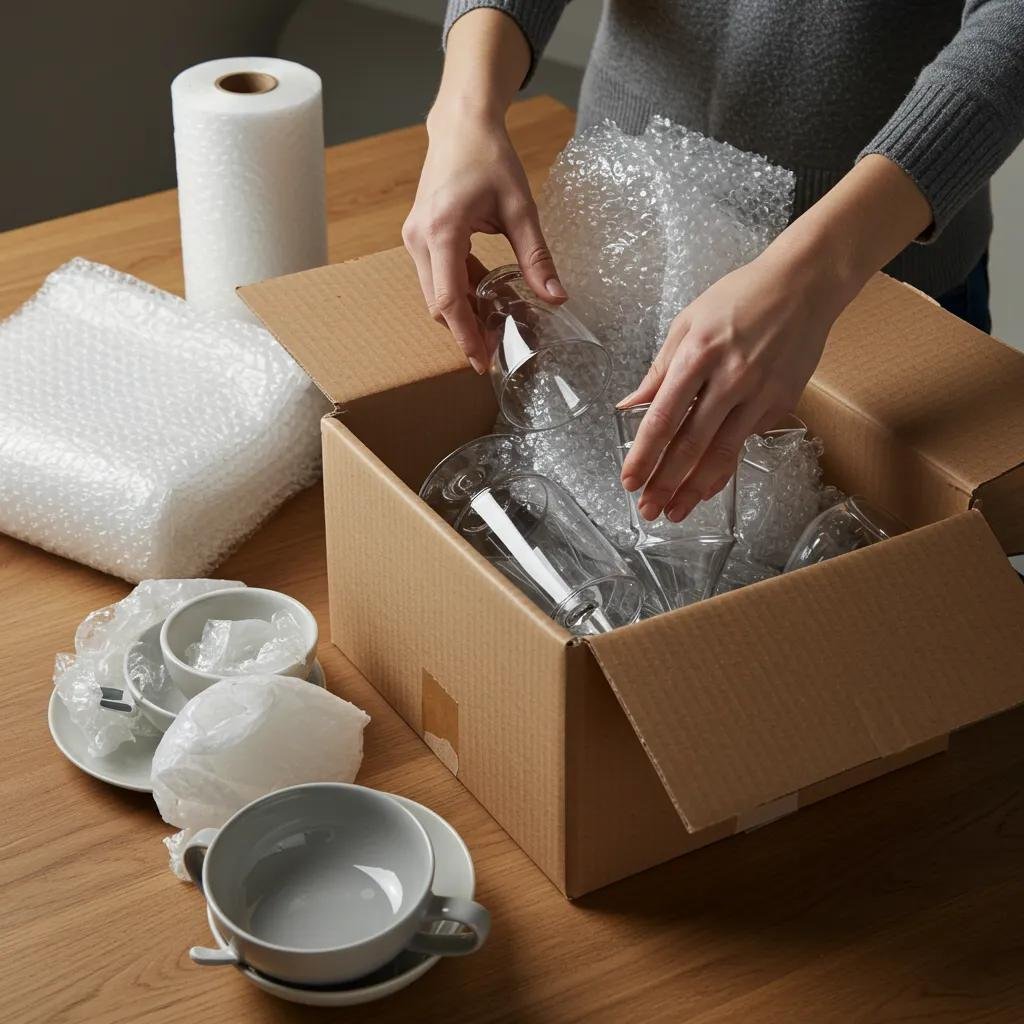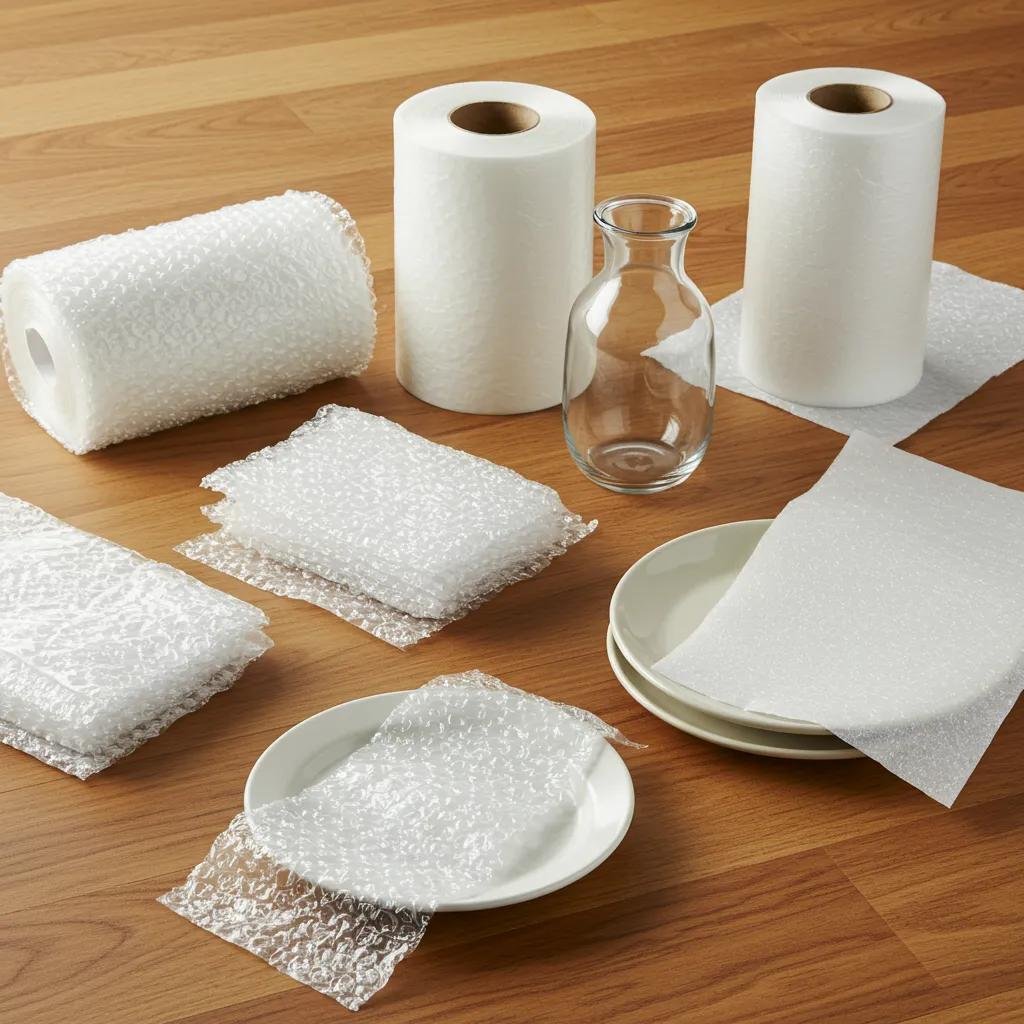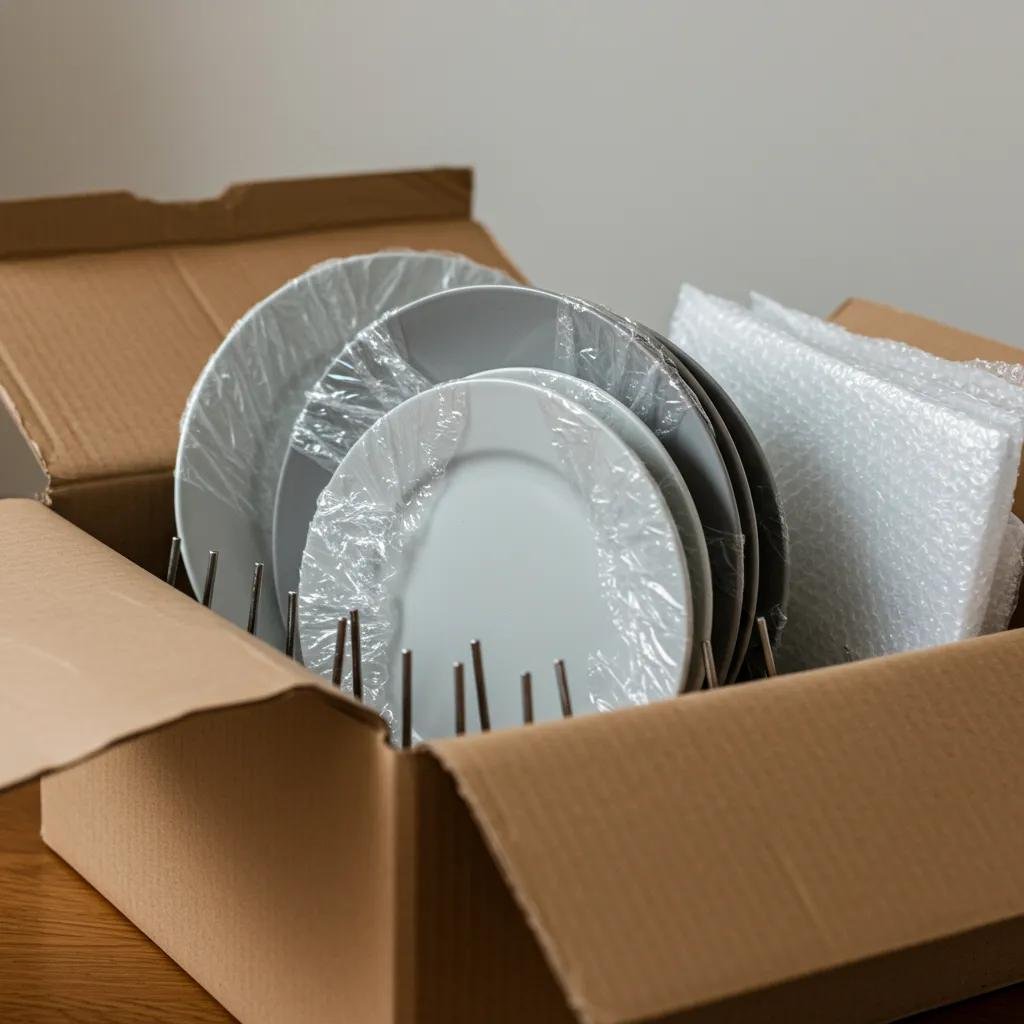
How to Safely Pack Fragile Items for Moving: Expert Guide to Protecting Delicate Belongings
Moving delicate possessions demands precise methods to prevent damage and reduce stress. This guide to packing fragile items unites best practices in cushioning, box selection, and handling with insights from 10 Men Movers’ professional packing services. You will learn why specialized care matters, which materials deliver optimal protection, step-by-step techniques for common breakables, decision points for hiring experts, a complete checklist, and how 10 Men Movers uniquely safeguards your valuables. By following this expert guide, you’ll discover proven strategies that ensure glasses, artwork, electronics, antiques, and beyond arrive intact in your new home.
Why Is Special Care Essential When Packing Fragile Items for Moving?
Fragile items require dedicated packing methods that absorb shock, restrict movement, and shield surfaces from abrasion. Proper handling addresses mechanical stresses—such as drops, collisions, and vibrations—that commonly occur during loading, transit, and unloading. Ensuring each piece is individually wrapped and densely cushioned creates a protective micro-environment that prevents cracks, chips, and scuffs. Recognizing these risks forms the foundation for selecting appropriate materials and techniques that minimize damage and emotional distress when unpacking.
What Risks Do Fragile Items Face During a Move?
Fragile belongings confront impact forces, sudden jolts, and weight shifts that can fracture glass, bend frames, or dislodge internal electronics. Rough road conditions and vibrations can cause micro-fractures in ceramics or delicate circuitry. Even minor compressive loads between boxes risk crushing thin walls or bending metal components. Understanding these damage mechanisms highlights why cushioning, void fill, and sturdy containment are indispensable for every delicate object.
How Does Proper Packing Reduce Breakage and Stress?
Effective packing combines individual wrapping, layered cushioning, and strategic void fill to neutralize forces that cause breakage. Wrapping each item in soft paper or foam eliminates direct contact between hard surfaces, while filling empty spaces prevents items from rattling. Securely sealing and labeling boxes ensures careful handling at every stage. These measures not only preserve the physical integrity of possessions but also provide peace of mind, reducing anxiety on moving day.
What Are the Best Packing Materials for Fragile Items?

Choosing the right supplies is crucial for safeguarding glass, ceramics, and electronics. Quality materials create a buffer against shock, moisture, and abrasion. The following recommendations reflect industry standards and eco-conscious innovations in 2025.
Which Cushioning Materials Protect Fragile Items Best?
Before grouping items, wrap each object in a cushioning layer that absorbs impact and prevents direct contact. Top options include:
- Bubble wrap: Multi-layer air pockets cushion against drops and compressive stress.
- Acid-free packing paper: Soft, tag-free sheets conform to shapes without leaving residues.
- Foam sheets and peanuts: Conformable foam fills irregular cavities and supports heavy items.
What Types of Specialty Boxes Are Ideal for Delicate Items?
Specialty packaging integrates reinforced construction and custom inserts to cradle specific shapes. Common box options include:
- Dish pack boxes: Deep, tall boxes with corrugated dividers for plates packed vertically.
- Mirror and artwork cartons: Extra-thick walls and corner protectors prevent frame damage.
- Crates for sculptures and antiques: Wooden or plywood construction custom-sized for irregular forms.
How Can Eco-Friendly Packing Supplies Help Protect Fragile Items?
Sustainable packing options now combine performance with reduced environmental impact. Biodegradable air pillows, recycled paper cushioning, and compostable foam alternatives cushion items while minimizing landfill waste. Certified compostable bubble wrap and reusable fabric wraps provide equivalent shock protection to conventional materials but align with circular economy principles. Adopting these green supplies reinforces care for both possessions and the planet.
How Do You Pack Common Fragile Items Safely for Moving?

Every category of breakable requires tailored steps that address its unique vulnerabilities. Professional movers apply category-specific protocols; you can replicate these at home to preserve precious items.
What Is the Best Way to Pack Fragile Kitchenware Like Dishes and Glasses?
Plates, bowls, and stemware demand vertical packing, individual wrapping, and compartmentalization to eliminate movement.
- Wrap each plate in packing paper, folding over edges twice.
- Stand plates vertically in a dish pack box with corrugated dividers.
- Cushion stemware by stuffing cups with paper, then wrap entire piece in bubble wrap before placing upright.
Packing dishes vertically distributes weight evenly and reduces leverage on fragile edges. This approach mirrors professional standards to secure delicate dinnerware.
Packing Strategies to Protect Fragile Items
These systems require avoiding placing heavy items on top of fragile items; this is a critical consideration when packing to prevent damage.
A comprehensive solution strategy for right-sized packaging, 2023
How Should Fragile Artwork and Mirrors Be Packed for Transport?
Artwork and mirrors benefit from edge protection, rigid support, and moisture barriers to prevent scratches and warping.
- Cover glass surfaces with interleaving acid-free paper.
- Apply corner protectors, then wrap the frame in bubble wrap.
- Slide into a mirror carton with built-in foam inserts or use custom art crates for oversized pieces.
Rigid enclosures and padding preserve both canvas and frame integrity, preventing shifting that leads to scratches or cracks.
What Are Safe Packing Techniques for Fragile Electronics?
Electronics need static protection, secure padding, and cable management to avoid internal damage.
- Place devices in anti-static bags to shield circuitry.
- Wrap each component in foam sheets, then surround with bubble wrap.
- Bundle cables separately in labeled zip bags to prevent tension on ports.
These measures maintain device functionality by preventing electrostatic discharge and mechanical stress.
How Can You Protect Collectibles and Antiques During a Move?
High-value heirlooms and antiques require documentation, specialized cushioning, and climate considerations.
- Photograph each item against a neutral background for inventory and insurance.
- Wrap in acid-free tissue and multiple layers of cushioning foam.
- Pack in custom-sized crates with vibration-dampening liners.
Documenting condition and using archival materials preserves provenance and prevents deterioration during transit.
When Should You Hire Professional Fragile Item Packing Services?
Deciding between DIY and expert packing hinges on item value, complexity, and insurance requirements. 10 Men Movers offers specialized fragile packing solutions that merge precision methods with full coverage options.
What Are the Benefits of Professional Fragile Packing by 10 Men Movers?
Professional fragile packing by 10 Men Movers ensures expert handling, time savings, and comprehensive insurance coverage. Trained packers apply category-specific techniques, from vertical dish packing to custom crate assembly. This service alleviates stress and reduces risk, making it ideal for valuable collections or tight schedules. Clients benefit from streamlined logistics, knowing each delicate belonging is protected under a professional umbrella.
How Do Professional Packers Handle Fragile Items Differently?
Expert packers integrate standardized wrapping sequences, custom inserts, and reinforced containers. They analyze fragility levels, select materials based on item weight and shape, and balance load assignments within each crate. Specialized training covers shock absorption science, ensuring minimal movement during transit. This systematic approach surpasses typical DIY methods by combining speed with precision.
Designing Efficient Packaging Lines for Fragile Items
Other packaging items that are fragile or delicate, or which require special handling, are often packed in a variety of ways. The design of efficient packaging lines is crucial for ensuring that these items are protected during transit.
Design for manual packaging, 2003
What Insurance Options Protect Fragile Items During Moving?
Valuable fragile items often qualify for declared value protection or full-replacement coverage when professionally packed. Policies can include coverage tiers up to total item value, addressing breakage, loss, and accidental damage. Claims processes are streamlined when items are inventoried and documented by moving professionals. Proper insurance selection complements physical packing safeguards to deliver complete risk management.
What Is a Complete Moving Fragile Items Checklist?
A structured checklist guides every phase of fragile item preparation, ensuring no step is overlooked. Use the following table to verify essential actions and materials.
| Task | Purpose | Outcome |
|---|---|---|
| Inventory and photography | Document condition before packing | Simplifies claims and tracks each item |
| Individual wrapping | Create protective micro-environment | Prevents surface contact and abrasion |
| Category-specific cushioning | Absorb shock and vibration | Reduces breakage risk |
| Void fill and secure sealing | Eliminate movement within boxes | Maintains item position under load |
| Clear labeling and handling marks | Direct careful placement and unloading | Ensures fragile boxes receive priority care |
Which Steps Ensure Securely Packing Breakables for Moving?
Begin with a detailed inventory and photos to record pre-move condition. Wrap items individually using acid-free paper or foam sheets, then apply a secondary layer of bubble wrap for shock resistance. Fill empty spaces with packing peanuts or crumpled paper to immobilize contents. Seal boxes with reinforced tape and label each as “FRAGILE” with arrows indicating upright orientation. These steps combine to create a resilient barrier against impacts.
How Should Fragile Boxes Be Labeled and Loaded?
Labeling must convey fragility, weight, and orientation for every carton. Use bold “FRAGILE” stamps, mark arrows for “This Side Up,” and note “Lightest” or “Heaviest” to guide stacking. During loading, position fragile boxes atop stable, non-slippery surfaces and secure them against movement with straps or wedge blocks. This systematic loading sequence prevents shifting loads from crushing delicate contents.
What Tools Can Help Assess Fragile Item Packing Needs?
Packing calculators estimate material quantities based on item dimensions and volume, avoiding over- or under-supply. Inventory apps track condition reports, generate labeling templates, and alert to specialty crate requirements. Assessment matrices map item fragility levels to recommended materials and box types. These tools streamline preparation and align DIY methods with professional standards.
How Does 10 Men Movers Ensure Safe Packing of Fragile Items?
10 Men Movers combines local expertise, advanced methodologies, and rigorous training to deliver reliable fragile item handling. Every move leverages proprietary protocols refined over 3,000+ relocations to minimize risks and optimize customer satisfaction.
What Customized Packing Solutions Does 10 Men Movers Offer?
Tailored packing plans start with an in-home consultation to evaluate item types, volumes, and fragility levels. Based on findings, 10 Men Movers designs a material mix—such as eco-friendly foam, heavy-duty dish boxes, and custom crates—to match each category of belongings. Specialized inserts and climate-controlled wraps accommodate fine art, electronics, and antiques, ensuring every piece receives bespoke protection.
How Does 10 Men Movers Train Movers for Fragile Item Handling?
Movers undergo intensive workshops covering fragility science, shock dynamics, and advanced wrapping sequences. Training includes simulated packing labs and on-the-job mentorship to perfect techniques for glassware, artwork, and electronics. Ongoing quality audits reinforce adherence to best practices and foster continuous improvement, guaranteeing consistent service excellence.
What Client Success Stories Demonstrate 10 Men Movers’ Fragile Packing Expertise?
A recent relocation of an extensive china collection overcame tight timelines and narrow staircases through custom wrap-and-crate solutions. Another client entrusted a vintage clock and heirloom figurines, which arrived undamaged thanks to multi-layer foam suspension inserts. These outcomes reflect 10 Men Movers’ commitment to precision and the satisfaction that comes from protected valuables arriving safely.
What Are Common FAQs About Packing Fragile Items for Moving?
Moving professionals observe recurring questions that highlight critical packing considerations. Clarifying these points supports both DIY enthusiasts and those evaluating expert services.
What Is the Best Way to Pack Glassware Without Using Paper?
Alternative glassware wraps include corrugated edge protectors paired with reusable silicone sleeves. Each glass fits into a molded insert within a dish pack box, eliminating paper use. This system cushions stems and bowls with shock-absorbent materials that resist compression and moisture, offering durable protection choice.
How Do Movers Pack Fragile Items to Prevent Damage?
Movers combine category-specific protocols: individual wrapping, void fill, and sequential loading strategies. They apply shock absorbers between box layers, distribute weight evenly, and use specialized equipment such as lift trucks and straps to prevent sudden jolts. Comprehensive documentation and careful handling complete the professional approach to minimize breakage.
What Materials Are Needed to Pack Fragile Items Safely?
Essential supplies include acid-free packing paper, multi-layer bubble wrap, foam sheets, packing peanuts, reinforced tape, specialty dish and mirror boxes, corner protectors, and eco-friendly air pillows. Selecting materials suited to each item’s shape, weight, and fragility level ensures a layered defense against impact, moisture, and abrasion.
Moving delicate belongings requires meticulous preparation, appropriate materials, and—when needed—professional expertise. By following this structured guide, applying the complete checklist, and leveraging 10 Men Movers’ specialized packing services, you can safeguard every fragile item and enjoy a smoother, stress-free move.
Frequently Asked Questions
What should I do if I run out of packing materials while packing fragile items?
If you find yourself short on packing materials while preparing fragile items, it’s essential to pause and reassess your supplies. Consider using alternative materials like towels or blankets for cushioning, as they can provide adequate protection. Additionally, you can quickly source more packing supplies from local stores or online retailers. It’s better to take the time to gather the necessary materials than to risk damaging your fragile belongings due to inadequate packing.
How can I ensure my fragile items are insured during the move?
To ensure your fragile items are insured during a move, first, check with your moving company about their insurance policies. Many companies offer basic coverage, but you may want to purchase additional insurance for high-value items. Document each fragile item with photographs and a detailed inventory list, which can help streamline the claims process if needed. Always read the fine print of your insurance policy to understand what is covered and any exclusions that may apply.
What are the signs that a fragile item has been damaged during the move?
Signs of damage to fragile items can include visible cracks, chips, or breaks upon unpacking. Additionally, if an item feels loose or unstable, it may have sustained internal damage. For electronics, check for functionality issues, such as failure to power on or unusual sounds. Always inspect items carefully as you unpack, and document any damage with photos for potential insurance claims. Early detection can help you address issues promptly.
Can I use regular boxes for packing fragile items?
While you can use regular boxes for packing fragile items, it’s not recommended. Standard boxes may lack the necessary reinforcement and cushioning to protect delicate belongings effectively. Instead, opt for specialty boxes designed for fragile items, such as dish pack boxes or mirror cartons, which provide better support and protection. If you must use regular boxes, ensure they are sturdy and add ample cushioning materials to minimize the risk of damage during transit.
What is the best way to label boxes containing fragile items?
Labeling boxes containing fragile items is crucial for ensuring careful handling. Use bold, clear markers to write “FRAGILE” on multiple sides of the box. Include arrows indicating the correct upright position and specify the contents if necessary. Additionally, consider using color-coded labels to differentiate fragile items from other boxes. This visual cue helps movers and anyone assisting with the move to prioritize these boxes and handle them with extra care.
How can I prepare my fragile items for long-term storage after moving?
To prepare fragile items for long-term storage after moving, start by cleaning each item thoroughly to remove dust and debris. Wrap them individually in acid-free packing paper or bubble wrap to prevent scratches. Use sturdy, labeled boxes for storage, ensuring they are not overpacked to avoid crushing. Store items in a climate-controlled environment to protect against humidity and temperature fluctuations. Regularly check on stored items to ensure they remain in good condition.
What should I do if I notice damage to my fragile items after the move?
If you notice damage to your fragile items after the move, document the damage immediately with photographs and detailed notes. If you purchased insurance, contact your moving company or insurance provider to initiate a claim. Provide them with the necessary documentation, including your inventory list and any evidence of the damage. If the damage is significant, consider consulting a professional for repair options, especially for valuable antiques or artwork.

